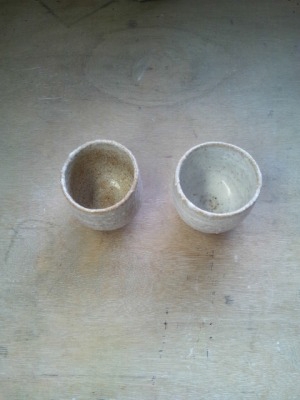Japanese Potteries(Explanations to the technical terms of ceramics No.10)
There are various technical words on potteries. Here are some of those, for which I'd like to give you some remarks.
Caring for your Pottery Vessels
Wishing to use the favorite potteries for a long time is just natural, and making use of them can be more pleasant by taking gentle care. Here are some tips about how to care for potteries.When you welcome a new pottery into your house, firstly you should turn it over and feel its bottom with your fingers. Isn't it a bit rough? Especially, some porous potteries may still have gritty small stones or sands remained on the surface. In that case, please polish it with sandpaper (of #100 or so). By doing so, you can start to use it without scratching a table.
You shouldn't put foods, particularly ones with oil or soy sauce, straight away in a new pottery you've bought, because that could cause the color or oil stains that will not come out. So, you just dip the pottery into tepid water first before using it. After that, there will be no trouble of stains or no odor transfer. This is not only for foods but also for some dark drinks like coffee. You'd better use cups after putting it slightly in water, although you don't have to be too nervous after the second time if you use it very often.

Though I have mentioned in the previous chapter of eDrinking (Tea)', when drinking hot tea, a thick pottery is better to be used.
By the way, among two Yunomi(s) (Japanese tea cups) in the photo, the right is brand-new, and the left is one that has been used for 5 years. Are you aware of the difference of the color? This is often expressed with the word, eSodatsu (or being grown)', which means the state that a Yunomi has got a nice expression. From ancient times, Japanese people have loved and grown potteries. The fondness for potteries in possession and the affection toward the one that has got nice color, luster and astringency in the length of time being together with the owner are included in the word. A brand-new tidy one may be good, however, such colored astringent one is good, too. In such grown potteries, the expression of coffee, black tea or green tea should be rich and elegant.
However, this does not apply to porcelain ware. Stains adhered to the white beautiful surface of porcelain may be just kind of dirty and we wouldn't say that it's nice aging. If a porcelain cup has started to be stained at around its bottom or opening, you should dip it into a bleaching agent or rub it lightly with a kitchen sponge soaked in some baking soda. Kitchen cleanser is not recommendable because it can damage the surface and make it to be easily stained again, or possibly takes off the painting on the surface.
You must be careful in the usual behavior to put potteries washed clean back to the cupboard. There's nothing wrong about porcelain ware but you should wait a minute about earthenware which is water-absorbent. If it is still wet when brought back to the closed cupboard, it may get moldy from its bottom. To avoid that, you should just make it dry all day long in the room. Please don't forget to do this especially about the one you don't use very often. It goes dry faster by once dipping it in boiled water after you washed it.
For using potteries you love for a long time, it is essential to take daily care.
